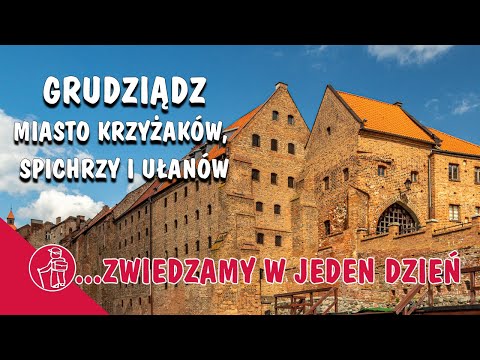GRUDZIĄDZ - MIASTO KRZYŻAKÓW, SPICHRZY I UŁANÓW. CO WARTO ZOBACZYĆ

Hello. Today we invite you to one of the most interesting cities on the European Route of Brick Gothic. We will tell you what, according to a famous chant, the lancers from Grudziądz were famous for and what was more important to them : a maiden or a horse. We will look at the famous
economic law, which is still effective today, delivered by Nicolaus Copernicus before the sejmik of the Prussian states. We will also check why the townspeople from Grudziądz reluctantly hosted King Sigismund III Vasa in their castle and what ends the love of lovers from warring nations. What is worth seeing in Poland. Kuyavia. Grudziądz pearl of European brick Gothic The first mentions of Grudziądz appear in the period of the first Piasts and are related to the unsuccessful missionary activity of Bishop Christian. Therefore, prince Konrad Mazowiecki brings to this area the Teutonic Order, which was to spread the Catholic faith here . From that time, until the mid-15th century, the city
was ruled by the knights of the Order of the Blessed Virgin Mary. It developed dynamically until the 17th century, when it fell victim to the constant wars waged by the Polish-Lithuanian Commonwealth. During the partitions, the city was taken over by the Prussian state, and a huge fortress was built in the vicinity . The greatest development of Grudziądz took place in the second half of the nineteenth and early twentieth centuries. A railway line was built, new industrial plants were built, and
one of the oldest active tram lines in Poland was opened in the city. In the twentieth century, due to the proximity of the border with Germany, numerous military units and the Cavalry Training Center , Gendarmerie, and the Air Shooting and Bombing School were located here . The 18th Regiment of Pomeranian Uhlans was also stationed here , mentioned by one of the short and rhymed chants describing the individual units "They have dudes like brass - These are the lancers from Grudziądz". After these beautiful times for Grudziądz, the Monument to the Uhlan with a girl remained , with the beautiful sentence of Bolesław Wieniawa-Długoszowski: Because the heart of the uhlan, when you put it on your hand: In the first place, a virgin, in front of a maiden ...
only a horse, and the Monument of the Polish Soldier on the market square, unveiled in 1930. As a result of the aggression of Nazi Germany, Grudziądz was under occupation. In 1945 the city was liberated, but unfortunately destroyed in 60%.
After the war, a systematic reconstruction process began. WATER GATE The Water Gate, which connects the city walls with the granary complex, is the only city gate that has survived to this day. It was erected at the beginning of the 14th century to allow a convenient passage from the port square towards the Teutonic castle. It was closed with a harrow, which currently has only a decorative function. It was destroyed during the fire of the town in 1659 and during the warfare in 1945. As a result of the post-war reconstruction, its façade from the town side was transformed , which meant that it lost its gothic character.
GRUDZIĄDZKIE SPICHRZE It is worth starting your tour of Grudziądz with probably the most famous attraction of the city - the Old Granaries, which can be seen on most of the photos and promotional materials. The first buildings were built under the Teutonic Order, but most of them were built after the city was incorporated into Poland. From the 15th century on, the demand for Polish grain, transported by the Vistula to Gdańsk, was growing in Western Europe . The towns on the Vistula River became important trade centers , and grain and other goods had to be stored somewhere.
From the side of the Vistula River, the buildings are multi -story, supported by high buttresses, while from the city side , they are mostly two-story, with the facade of an ordinary tenement house. The huge wall of warehouses built on the steep Vistula escarpment, apart from its component part, also had a defensive function, thanks to extremely thick walls , up to 2 meters wide and small windows. This is evidenced by cannonballs embedded in the facades. The oldest of the granaries is now occupied by the municipal museum. It houses a permanent exhibition on the history of the city and its development from the Middle Ages to 1939, as well as an archaeological exhibition. We can find here monuments
illustrating the history of the city under the Teutonic rule and in the heyday after the Second Peace of Toruń. Original documents, military items , coins, everyday objects and guild memorabilia attract attention . If you like our video, please keep a thumbs up, and consider subscribing to the channel and enabling notifications.
Monastery of Benedictine At the end of the 13th century, a hospital with its own church was built at the Water Gate . First maintained by the Teutonic Order, then, after a fire in the 14th century, by the Grudziądz parish church , it survived until the 16th century, when it was converted into an Evangelical church. In the 17th century, Benedictine nuns settled here, who built a monastery and a school for girls. After the dissolution of the order in the 19th century, it housed a teachers' college, and during the wars, an old people's home.
The Grudziądz Museum was established in the buildings rebuilt after the war. Currently, in the former monastery building, there is a Gallery of Contemporary Pomeranian Painting, presenting the works of artists associated with Pomerania since 1945 . In the adjacent Abbot's Palace, which also served as a monastery gate, there is an exhibition devoted to the Cavalry Training Center in Grudziądz. The Teutonic Castle and the KLIMEK TOWER On the highest hill in Grudziądz, in the years 1260-1299, the Teutonic Knights erected a defensive castle, which was one of the strongest monastic fortresses . The main castle had a quadrilateral plan surrounded by an additional second ring of perimeter walls. In the north-west corner there was a huge free-standing tower called Klimek, which also served as a prison. It had a diameter of almost 9 meters and a height of about 30 meters, the entrance led through a wooden platform from the porch of the perimeter wall. A 50 m deep well was also dug in the courtyard.
On the eve of the Thirteen Years' War, the Prussian Union denounced its obedience to the order and four days later the insurgents captured the castle. Several attempts to recapture the Teutonic Knights turned out to be ineffective. The Second Peace of Toruń finally located the city within the Polish borders. As the seat of the starosty, the castle hosted, among others, Zygmunt August, Władysław IV, Stefan Batory and Jan III Sobieski. On the other hand, Sigismund III Vasa was not very well received , and his visit cost the city more than 500 fines, of which 322 were reportedly spent only on the wine itself, i.e. the equivalent of 65 kg of silver. During the Swedish Deluge, the castle with a small crew surrendered after a short artillery fire. At the time when the Swedish army was
occupying Grudziądz, a beautiful townswoman fell in love with a Swedish officer, and with reciprocity! Their love was so great that they planned an escape together. When the father heard about it, he became furious and ordered to murder his beloved daughter. When the woman arrived at the meeting place, she was shocked and despaired when she saw the dead body of her beloved.
Desperate, she threw all the valuables prepared for the journey into a deep well and entered the local Benedictine nunnery . According to legend, to this day no one has managed to recover these treasures. In 1659, the castle and the town were regained by the Lubomirski army. For the following years and wars, the castle was occupied by the Swedish, Prussian and Russian troops . From each of these occupations, the castle was less equipped and more damaged, to such an extent that in 1801 Frederick William III ordered the demolition of the stronghold in order to obtain building material for the newly built fortress. In the mid-nineteenth century,
a park was arranged in the area of the ruins. Only the well and the Klimek tower remained of the castle , which was blown up by retreating German troops in 1945. In 2013-2014, the ruins were revitalized and an observation tower modeled on the former Klimek tower was built. Today you can admire the panorama of the city and the Vistula valley from it.
MARKET MARKET Grudziądz market, as it resulted from the location under the Chełmno law , is a square in the shape of a rectangle with eight streets at four corners. This layout of the market and streets is modeled on the Castrum Romanum, a fortified camp of Roman legionnaires. In the past, until 1851, there was a merchant house and a gothic town hall in the center. Until the mid- nineteenth century, it was surrounded by wooden, single-story buildings, which were replaced by baroque tenement houses. Almost all buildings were destroyed during World War II and rebuilt in a style reminiscent of the original. The oldest surviving tenement house is the house
at number 20, "Pod Łabędziem", from the turn of the 16th and 17th centuries . The buildings at the market square are dominated by the modernist building of KMPIK, formerly the Korzeniewski Brothers Department Store , built in 1914. In the interwar period, it was the largest commercial building in Pomerania. On the market square, it is also worth sitting on a bench with the famous Polish astronomer Nicolaus Copernicus for a moment . However, it did not stand here because of his stellar
achievements, but because in 1522 in Grudziądz, he delivered his "Treatise on the coin" before the sejmik of the Prussian states, which proclaimed that worse money pushes out better. It concerned two means of payment in circulation at that time: bullion coins and nominal coins . In practice, this meant that coins rich in ore were retained or transported abroad , and only weak nominal coins remained in local circulation. This law is known in the west as the Gresham Law, while in Poland it is known as the Copernicus-Gresham Law. The Old Town Square was renovated in 2010. Charming
streets with a few cozy cafes and restaurants depart from it . The most interesting impressions are made by ul. Mikołaja Reja, colloquially known as the avenue with umbrellas. THE BASILICA OF ST. MIKOŁAJA Church of St. Nicholas is the oldest church in Grudziądz. It was built in stages for nearly 150 years. The first chancel was built around 1286, in the 14th century the body of the temple was built, and at the beginning of the 15th century, the tower was covered with a tent cupola. Unfortunately, the rich Gothic
furnishings of the church were destroyed in the 16th century, when the Evangelicals took over the church during the Reformation . At the end of the 19th century, the church was thoroughly renovated in the neo-Gothic style. The church, heavily damaged during World War II, was rebuilt in the late 1940s. An extremely interesting monument is the 13th-century Gotland font , decorated with floral ornaments, dragons and mascarons, with a Romanesque granite goblet. She was probably brought to Grudziądz by the Vikings. There are also two granite stoups from the 13th - 14th centuries, located in the northern and western porches. From the old interior decorations,
fragments of polychrome from the end of the 14th century have been preserved on the inter-nave pillar. The most interesting monuments include the main altar with sculptures of saints. In the middle field of the altar there is an image of St. Nicholas by Jerzy Hoppen from 1950 in place of the damaged original. It is worth seeing the side altar with a painting of the Mother of God and Child from the 17th century, in a silver dress from the beginning of the 18th century, enriched with two gilded crowns. In the church
we can also find 17th-century paintings: St. Anna Samotrzec, St. Nicholas and the Coronation of the Blessed Virgin Mary, painted on wood, according to tradition from the castle chapel , and the 18th-century painting of St. Anthony in a neo-Gothic frame. JESUIT COLLEGE AND CHURCH The Jesuits were brought to Grudziądz in 1622 thanks to the efforts of Jan Działyński. Initially, they occupied the ancestral chapel in the church of St.
Nicholas in order to build his own college and temple at the turn of the 17th and 18th centuries . The 18th century was the greatest boom of the university, where students from all over Royal Prussia received their education. The dissolution of the order took place in 1781 and from that time the building was used by the gymnasium first, and then by the teachers' seminary. In 1897, the building became the seat of the municipal authorities and has remained so to this day. A single-nave, baroque church was built next to the college. Its eighteenth-century interior is the work of Józef Krause, and the painted decorations were made by Jesuit Ignacy Steiner.
Inside, there are three richly carved altars. The monumental main altar was founded by Jan Czapski, the Chełmno voivode. St. Franciszek Ksawery was transferred in 1722 from Jabłonowo Pomorskie, where he was worshiped as miraculous. Side altars of the Immaculate Conception of the Blessed Virgin Mary and St. Ignatius of Loyola
served as a model for, among others, for furnishing the Bernardine church in Toruń. It is also worth paying attention to the pulpit and the music choir, decorated with Chinese motifs. Thank you for watching the full movie. Please
leave a thumbs up, write in the comments about your impressions, share it with your friends and remember to subscribe.
2021-05-25 16:02


